词汇学知识点总结
英语词汇学知识点整理
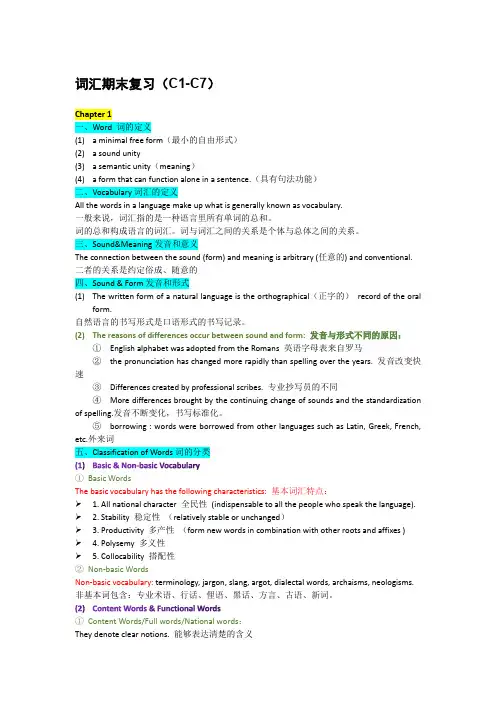
词汇期末复习(C1-C7)Chapter 1一、Word 词的定义(1) a minimal free form(最小的自由形式)(2) a sound unity(3) a semantic unity(meaning)(4) a form that can function alone in a sentence.(具有句法功能)二、Vocabulary词汇的定义All the words in a language make up what is generally known as vocabulary.一般来说,词汇指的是一种语言里所有单词的总和。
词的总和构成语言的词汇。
词与词汇之间的关系是个体与总体之间的关系。
三、Sound&Meaning发音和意义The connection between the sound (form) and meaning is arbitrary (任意的) and conventional. 二者的关系是约定俗成、随意的四、Sound & Form发音和形式(1)The written form of a natural language is the orthographical(正字的)record of the oralform.自然语言的书写形式是口语形式的书写记录。
(2)The reasons of differences occur between sound and form: 发音与形式不同的原因:①English alphabet was adopted from the Romans 英语字母表来自罗马②the pronunciation has changed more rapidly than spelling over the years. 发音改变快速③Differences created by professional scribes. 专业抄写员的不同④More differences brought by the continuing change of sounds and the standardization of spelling.发音不断变化,书写标准化。
词汇学复习
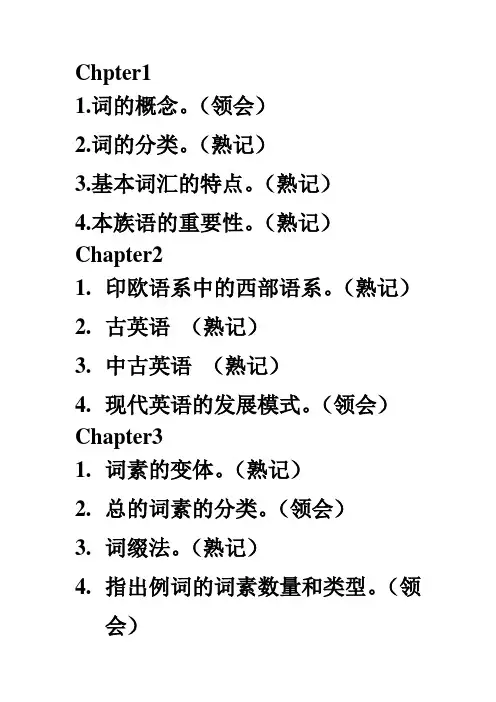
1.词的概念。
(领会)2.词的分类。
(熟记)3.基本词汇的特点。
(熟记)4.本族语的重要性。
(熟记)Chapter21.印欧语系中的西部语系。
(熟记)2.古英语(熟记)3.中古英语(熟记)4.现代英语的发展模式。
(领会)Chapter31.词素的变体。
(熟记)2.总的词素的分类。
(领会)3.词缀法。
(熟记)4.指出例词的词素数量和类型。
(领会)1.前缀的分类。
(熟记)2.转类法的类型。
(领会)3.部分转类法和完全转类法区别.(熟记)4.拼缀法类型。
(领会)5.截断法的概念。
(熟记)6.指出给的例词属于合成词,派生词,转类法的词,拼缀法,截断法,首字母缩略词,首字母拼音词,逆生法,来自于专有名词的词中的哪一个。
Chapter51.所指的概念。
(熟记)2.词的理据。
(熟记)3.理据的分类。
(领会)4.概念意义。
(熟记)5.褒义和贬义。
(领会)Chpter61.同义词的分类。
(熟记)2.反义词的分类。
(领会)3.上下义关系概念。
(熟记)4.语义场的作用。
(熟记)Chapter71.语义的扩大和缩小。
(领会)2.语义的降格。
(熟记)3.语境的作用。
(熟记)Chapter91.习语的特点。
(领会)2.习语的变异形式。
(领会)Chapter101. 单语词典和双语词典。
(熟记)。
词汇学复习资料
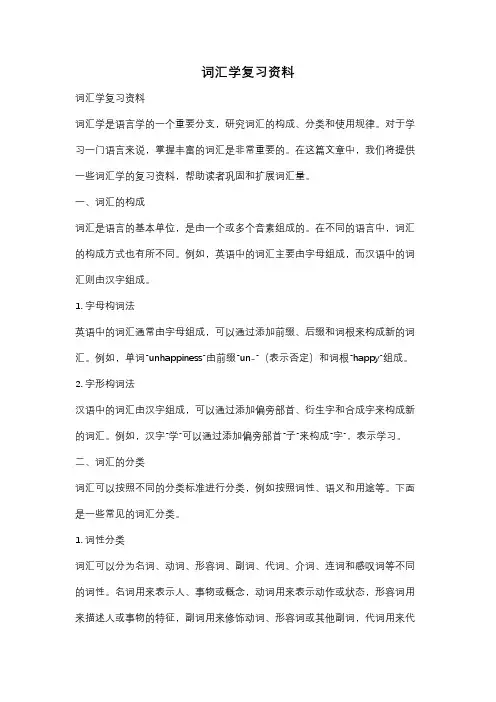
词汇学复习资料词汇学复习资料词汇学是语言学的一个重要分支,研究词汇的构成、分类和使用规律。
对于学习一门语言来说,掌握丰富的词汇是非常重要的。
在这篇文章中,我们将提供一些词汇学的复习资料,帮助读者巩固和扩展词汇量。
一、词汇的构成词汇是语言的基本单位,是由一个或多个音素组成的。
在不同的语言中,词汇的构成方式也有所不同。
例如,英语中的词汇主要由字母组成,而汉语中的词汇则由汉字组成。
1. 字母构词法英语中的词汇通常由字母组成,可以通过添加前缀、后缀和词根来构成新的词汇。
例如,单词“unhappiness”由前缀“un-”(表示否定)和词根“happy”组成。
2. 字形构词法汉语中的词汇由汉字组成,可以通过添加偏旁部首、衍生字和合成字来构成新的词汇。
例如,汉字“学”可以通过添加偏旁部首“子”来构成“字”,表示学习。
二、词汇的分类词汇可以按照不同的分类标准进行分类,例如按照词性、语义和用途等。
下面是一些常见的词汇分类。
1. 词性分类词汇可以分为名词、动词、形容词、副词、代词、介词、连词和感叹词等不同的词性。
名词用来表示人、事物或概念,动词用来表示动作或状态,形容词用来描述人或事物的特征,副词用来修饰动词、形容词或其他副词,代词用来代替名词,介词用来表示位置、时间或方式,连词用来连接词语或句子,感叹词用来表示强烈的情感。
2. 语义分类词汇可以按照词义的相似性进行分类。
例如,可以将名词按照人、动物、植物、物体、抽象概念等进行分类;将动词按照行为、状态、感觉、思维等进行分类;将形容词按照颜色、大小、形状、性质等进行分类。
3. 用途分类词汇可以按照在句子中的作用进行分类。
例如,可以将词汇分为实词和虚词。
实词包括名词、动词、形容词和副词,它们在句子中起到实际的意义;虚词包括代词、介词、连词和感叹词,它们在句子中起到连接或修饰的作用。
三、词汇的使用规律词汇的使用规律是指在特定语境中使用词汇的约束条件。
不同的语言和不同的语境中,词汇的使用规律也有所不同。
英语词汇知识点归纳
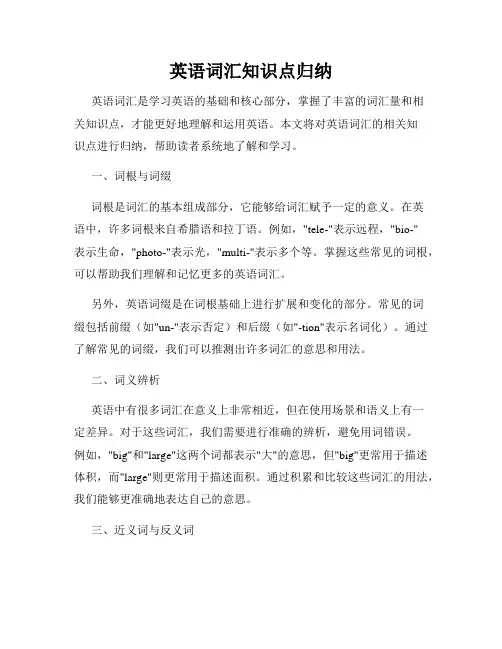
英语词汇知识点归纳英语词汇是学习英语的基础和核心部分,掌握了丰富的词汇量和相关知识点,才能更好地理解和运用英语。
本文将对英语词汇的相关知识点进行归纳,帮助读者系统地了解和学习。
一、词根与词缀词根是词汇的基本组成部分,它能够给词汇赋予一定的意义。
在英语中,许多词根来自希腊语和拉丁语。
例如,"tele-"表示远程,"bio-"表示生命,"photo-"表示光,"multi-"表示多个等。
掌握这些常见的词根,可以帮助我们理解和记忆更多的英语词汇。
另外,英语词缀是在词根基础上进行扩展和变化的部分。
常见的词缀包括前缀(如"un-"表示否定)和后缀(如"-tion"表示名词化)。
通过了解常见的词缀,我们可以推测出许多词汇的意思和用法。
二、词义辨析英语中有很多词汇在意义上非常相近,但在使用场景和语义上有一定差异。
对于这些词汇,我们需要进行准确的辨析,避免用词错误。
例如,"big"和"large"这两个词都表示"大"的意思,但"big"更常用于描述体积,而"large"则更常用于描述面积。
通过积累和比较这些词汇的用法,我们能够更准确地表达自己的意思。
三、近义词与反义词除了词义的辨析外,英语中还存在许多近义词和反义词。
近义词指的是意思相近但用法略有差异的词汇;反义词则指的是意义完全相反的词汇。
例如,"happy"和"joyful"就是近义词,"happy"强调一种普通的快乐,而"joyful"则强调更加强烈和欢乐的感觉。
"happy"的反义词是"sad","joyful"的反义词则是"sorrowful"。
英语词汇学知识点归纳总结
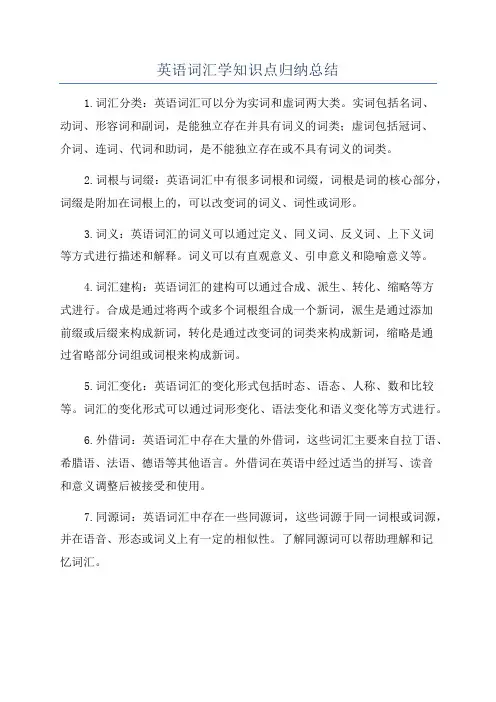
英语词汇学知识点归纳总结
1.词汇分类:英语词汇可以分为实词和虚词两大类。
实词包括名词、
动词、形容词和副词,是能独立存在并具有词义的词类;虚词包括冠词、
介词、连词、代词和助词,是不能独立存在或不具有词义的词类。
2.词根与词缀:英语词汇中有很多词根和词缀,词根是词的核心部分,词缀是附加在词根上的,可以改变词的词义、词性或词形。
3.词义:英语词汇的词义可以通过定义、同义词、反义词、上下义词
等方式进行描述和解释。
词义可以有直观意义、引申意义和隐喻意义等。
4.词汇建构:英语词汇的建构可以通过合成、派生、转化、缩略等方
式进行。
合成是通过将两个或多个词根组合成一个新词,派生是通过添加
前缀或后缀来构成新词,转化是通过改变词的词类来构成新词,缩略是通
过省略部分词组或词根来构成新词。
5.词汇变化:英语词汇的变化形式包括时态、语态、人称、数和比较等。
词汇的变化形式可以通过词形变化、语法变化和语义变化等方式进行。
6.外借词:英语词汇中存在大量的外借词,这些词汇主要来自拉丁语、希腊语、法语、德语等其他语言。
外借词在英语中经过适当的拼写、读音
和意义调整后被接受和使用。
7.同源词:英语词汇中存在一些同源词,这些词源于同一词根或词源,并在语音、形态或词义上有一定的相似性。
了解同源词可以帮助理解和记
忆词汇。
8.词汇扩展:英语词汇在发展的过程中会发生扩展,即一个词从最初的特定意义扩展到更广泛的意义。
词汇扩展可以通过引申、转义、隐喻等方式进行。
这些是英语词汇学中的一些主要知识点,通过对这些知识点的学习和理解,可以更好地掌握和应用英语词汇。
词汇学知识点
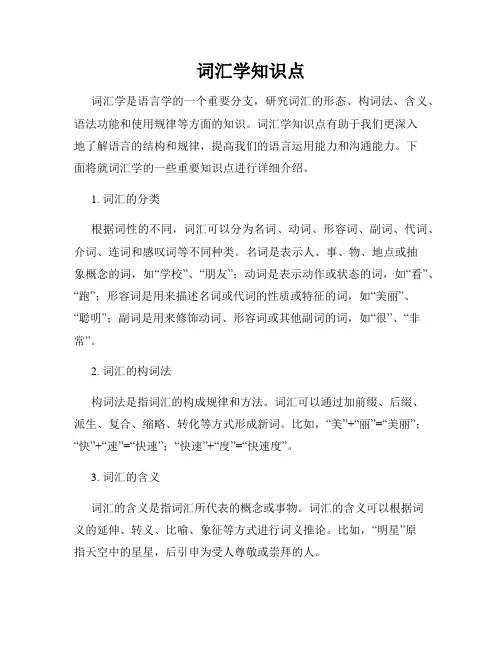
词汇学知识点词汇学是语言学的一个重要分支,研究词汇的形态、构词法、含义、语法功能和使用规律等方面的知识。
词汇学知识点有助于我们更深入地了解语言的结构和规律,提高我们的语言运用能力和沟通能力。
下面将就词汇学的一些重要知识点进行详细介绍。
1. 词汇的分类根据词性的不同,词汇可以分为名词、动词、形容词、副词、代词、介词、连词和感叹词等不同种类。
名词是表示人、事、物、地点或抽象概念的词,如“学校”、“朋友”;动词是表示动作或状态的词,如“看”、“跑”;形容词是用来描述名词或代词的性质或特征的词,如“美丽”、“聪明”;副词是用来修饰动词、形容词或其他副词的词,如“很”、“非常”。
2. 词汇的构词法构词法是指词汇的构成规律和方法。
词汇可以通过加前缀、后缀、派生、复合、缩略、转化等方式形成新词。
比如,“美”+“丽”=“美丽”;“快”+“速”=“快速”;“快速”+“度”=“快速度”。
3. 词汇的含义词汇的含义是指词汇所代表的概念或事物。
词汇的含义可以根据词义的延伸、转义、比喻、象征等方式进行词义推论。
比如,“明星”原指天空中的星星,后引申为受人尊敬或崇拜的人。
4. 词汇的语法功能词汇在句子中具有不同的语法功能,如名词可以作主语、宾语、定语、表语等;动词可以表示主谓关系、宾语关系、状语关系等;形容词和副词可以修饰名词或代词等。
5. 词汇的使用规律词汇在语言运用中有一定的使用规律,比如词的搭配、语法环境、语言风格等。
正确地运用词汇有助于提高语言表达的准确性和丰富性。
通过以上对词汇学知识点的介绍,我们可以更系统地了解词汇在语言中的作用和重要性,进一步提高我们的语言水平和表达能力。
希望大家都能在学习词汇学知识点的过程中取得更好的成绩,展现自己在语言运用方面的能力。
【正文结束】。
词汇学知识点总结
词汇学知识点总结词汇学是语言学的一个重要分支,研究的是词汇的形成、结构和意义等方面的问题。
在学习英语等外语的过程中,词汇是其中一个重要的组成部分。
下面,本文将对词汇学的一些知识点进行总结与归纳。
一、词的形态学词的形态学是词汇学中必须掌握的一个重要方面,主要包括词的构词法、屈折变化和派生变化等。
词的构词法指的是如何通过组合原有的词来创造新词,包括派生法、合成法、缩略法、转化法等。
屈折变化指根据语法要求,变化词的形态以表示不同的格、时、数、性等。
派生变化则指通过在原有词基础上添加字母或词缀等来产生新的词。
掌握词的形态学是很有必要的,因为它和词汇的理解和使用密切相关。
二、词的分类在英语中,词可以根据其不同的语法特征被归为不同的类别,常见的类别包括名词、代词、动词、形容词、副词、介词、连词和感叹词等。
不同的词在句子中扮演着不同的角色,掌握各类别之间的区别以及它们在句子中的作用,可以帮助我们更好地理解和表达语言。
三、词义词义是从语言学的角度定义词的意义,包括原义和引申义。
原义指的是一个词最基本的意思,而引申义则是在原义基础上经过延伸、扩展而得到的新意义。
同一个词的不同意义和语言环境等也会导致其含义的变化,例如“bank”既可以表示银行,也可以表示河岸等。
在学习外语的过程中,掌握词义是十分重要的。
四、词汇的学习方法词汇的学习是英语学习中最基础也最重要的部分之一,因此选择适合自己的学习方法对于提高词汇量、扩大词汇面积至关重要。
常用的学习方法包括反复背诵、积累单词簿、整理词根词缀、阅读和听力等。
在学习方法上,以选择适合自己和有用的方法为主,同时注意与语言运用的联系,不断地推广和实践。
五、词汇的应用掌握了词汇学的知识和学习方法后,其实就迈出了学习英语的第一步。
在实际运用中,如何运用得当也是至关重要的环节。
为了提高语言的流利度,需要在口语和书面语两个方面加强实践,增强实际运用能力。
另外,可以较晚多在社交网络等平台上与外国人联系,使用所学的词汇,将知识应用到实际交流之中,效果更佳。
英语词汇学知识点整理
词汇期末复习(C1-C7)Chapter 1一、Word 词的定义(1) a minimal free form(最小的自由形式)(2) a sound unity(3) a semantic unity(meaning)(4) a form that can function alone in a sentence.(具有句法功能)二、Vocabulary词汇的定义All the words in a language make up what is generally known as vocabulary.一般来说,词汇指的是一种语言里所有单词的总和。
词的总和构成语言的词汇。
词与词汇之间的关系是个体与总体之间的关系。
三、Sound&Meaning发音和意义The connection between the sound (form) and meaning is arbitrary (任意的) and conventional. 二者的关系是约定俗成、随意的四、Sound & Form发音和形式(1)The written form of a natural language is the orthographical(正字的)record of the oralform.自然语言的书写形式是口语形式的书写记录。
(2)The reasons of differences occur between sound and form: 发音与形式不同的原因:①English alphabet was adopted from the Romans 英语字母表来自罗马②the pronunciation has changed more rapidly than spelling over the years. 发音改变快速③Differences created by professional scribes. 专业抄写员的不同④More differences brought by the continuing change of sounds and the standardization of spelling.发音不断变化,书写标准化。
词汇学知识点总结
词汇学知识点总结词汇学是研究词汇的学科,它是语言学的一个重要分支,涉及了语言的构成、变化和使用等方面。
词汇学对于语言的理解和应用具有重要的意义,它不仅可以帮助我们更好地掌握语言知识,还可以帮助我们提高语言运用能力。
在这篇文章中,我们将对词汇学的知识点进行总结,帮助读者更好地理解和掌握这一学科。
一、词的定义和分类词是语言中的最小意义单位,是构成句子和表达意思的基本单位。
按照在句子中的功能和语法特征,词可以分为实词和虚词两大类。
实词包括名词、动词、形容词、副词等,它们能够表示具体的事物或抽象的概念;虚词包括代词、连词、介词、助词等,它们通常用来连接或修饰实词,没有明确的词义。
二、词汇的构成词汇的构成是指词的组成方式和形态特征。
在词汇的构成中,我们可以看到一些常见的构词法,如前缀、后缀、派生、合成、转化等。
通过这些构词法,我们可以对词汇进行灵活组合和创造,丰富语言的表达能力。
1.前缀前缀是指加在词根前面的一个字,可以改变词的词义或语法特征。
比如,“un-”表示否定,“re-”表示再次,“pre-”表示在前面等。
2.后缀后缀是指加在词根后面的一个字,同样可以改变词的词义或语法特征。
比如,“-ing”表示进行时,“-ful”表示充满的意思,“-ment”表示名词化等。
3.派生派生是指通过词根和词缀的组合来创造和衍生新的词。
比如,“happy”是一个形容词,通过加上“-ness”后缀就可以派生出名词“happiness”。
4.合成合成是指两个或多个词汇组合在一起,形成一个新的词。
比如,“blackboard”由“black”和“board”两个实词组合而成。
5.转化转化是指一个词汇的词类发生改变,但词形不变。
比如,“work”可以作为动词,也可以作为名词,它的词形都不发生变化。
词汇的构成方式是多种多样的,通过学习这些构词法,我们可以更好地理解和掌握词汇的形态特征,有助于提高我们的语言表达能力。
三、词汇的语义特征语义是指词汇所携带的意义,它是语言交流和理解的基础。
英语词汇学知识点归纳
英语词汇学知识点归纳英语词汇学是研究词汇的学科,主要研究词汇的形成、发展、构造和使用规律。
以下是一些英语词汇学的主要知识点。
1. 词汇分类:英语词汇可以分为原生词汇和派生词汇。
原生词汇是指直接来源于英语语言的词汇,而派生词汇则是通过加前缀、后缀或改变词性形成的新词。
2. 词根、前缀和后缀:许多英语单词都有共同的词根,通过添加前缀和后缀,可以构成各种派生词。
例如,'un-'是一个常见的前缀,表示否定,如'unhappy'(不快乐)。
3. 同义词和反义词:同义词具有相似的意思,可以在不同的上下文中互换使用,例如'big'和'large'。
反义词则是意思相反的词汇,如'hot'和'cold'。
4. 合成词:合成词是由两个或多个独立的词组合而成的词汇。
例如,'sunflower'(向日葵)由'sun'(太阳)和'flower'(花)组成。
5. 词源学:词源学研究词汇的起源和演变过程。
许多英语单词来自其他语言,如拉丁语、法语和希腊语。
了解词源可以帮助我们理解词汇的含义和用法。
6. 词义的变化:词汇的意义会随时间和语境的变化而变化。
一些词汇可能会产生新的意义或失去原有的意义。
例如,'mouse'(老鼠)最初是指一种小动物,现在也可以指计算机的输入设备。
7. 词汇的语法功能:词汇在句子中扮演不同的语法角色,如名词、动词、形容词等。
了解词汇的语法功能可以帮助我们正确使用它们。
8. 语义关系:词汇之间存在各种语义关系,如同义关系、反义关系、上下位关系等。
了解这些关系可以帮助我们扩展词汇量,提高语言表达能力。
9. 词汇的习得和记忆:习得和记忆词汇是学习英语的重要一部分。
采用合适的记忆方法,如使用词汇卡片、词汇表等,可以帮助我们更好地掌握词汇。
以上是英语词汇学的一些主要知识点。
- 1、下载文档前请自行甄别文档内容的完整性,平台不提供额外的编辑、内容补充、找答案等附加服务。
- 2、"仅部分预览"的文档,不可在线预览部分如存在完整性等问题,可反馈申请退款(可完整预览的文档不适用该条件!)。
- 3、如文档侵犯您的权益,请联系客服反馈,我们会尽快为您处理(人工客服工作时间:9:00-18:30)。
词汇学期末复习1.In brief, a word may be defined as a fundamental unit of speech and minimum free form; with a unity of sound and meaning (both lexical and grammatical meaning), capable of performing a given syntactic function.2.The morpheme (词素) is the smallest meaningful linguistic unit of language, not divisible or analyzable into smaller forms.Example:One morpheme: nationTwo morphemes: nation-alThree morphemes: nation-al-izeFour morphemes: de-nation-al-ize3. An allomorph (词素变体) is any of the variant forms of a morpheme as conditioned by position or adjoining sounds.For example:go: went, gone-ion/-tion/-sion/-ation are the positional variants of the same suffix.4.Inflectional affixes (曲折词缀)Affixes attached to the end of words to indicate grammatical relationships are inflectional, thus known as inflectional morphemes. For example: cats, walked, walking, John’s book…5.Derivational affixes (派生词缀)Affixes added to other morphemes to create new words. They can be further divided into prefixes and suffixes.For example:re+write, mini+car,work+er6.Connotative meaning (内涵意义)In contrast to denotative meaning, connotative meaning refers to the overtones or associations which a word suggests or implies.Mother (a female parent) is often associated with ‘love’, ‘care’, ‘tenderness’, ‘forgiving’, etc.Home (a dwelling place) may suggest ‘family, warmth, safety, love, convenience’, etc7.Stylistic meaning (文体意义)Words may have stylistic features, which make them appropriate for different contexts. Examples: male parent, father, daddy ;residence, home, pad8.Affective meaning (情感意义)Affective meaning indicates the speaker’s attitude towards the person or thing in question. Words that have emotive values may fall into two categories:Appreciative or commendatory (褒义): words of positive overtones used to show appreciation or approval. eg: love, cherish, prize, admire, worship, charm .Pejorative or derogatory (贬义): words of negative connotations imply disapproval, contempt or criticism. eg : hate, vicious .9.Collocative meaning (搭配意义)Collocative meaning consists of the associations a word acquires in its collocation. In otherwords, it is that part of the word meaning suggested by the words before or after the word in discussion.eg:pretty: girl, woman, flower, etc. handsome: boy, man, car, etc.10.a) Radiation辐射型:It is the semantic process in which the primary meaning stands at the centre and the secondary meaning radiates out of it.Though all the secondary meanings are independent of one another, they can all be traced back to the primary meaning.face head11.b) Concatenation 连锁型:It is the semantic process in which the meaning of a word moves gradually away from its primary meaning in succession so that the present meaning seems to have no connection to the primary meaning.E.g.candidate:1) white-roped2) office seeker in white gowns3) a person who seeks an office4) a person proposed for a place, award, etc.12.Linguistic context can be subdivided into lexical context and grammatical context.a) lexical context: refers to the lexemes that co-occur with the word in question. The meaning of the word is often affected and defined by the neighbouring lexemes.E.g“paper”: a term paper ,today’s paper ;"do " : do one’s teeth: brush ,do fish: cook.13.b) grammatical context: In some cases, the meanings of a polysemant may be influenced by the structure in which it occurs.E.g.“become”become + adj./n. , means‘begin to be’become + pron./n. , means ‘suit, befit’become + of, means ‘happen to, often in a bad way’1.Causes of changes in word meaning1)historical cause :It often happens that though a word retain its original form, its meaning has changed because the object it denotes has changed, this is the historical cause of semantic change.eg.pencil (from Latin word meaning)—a little tail or a fine brush, like our Chinese penwhen it was made of wood and graphite石墨,it was still called a “pencil”2)Social cause : Change in word meaning results from a constant verbal traffic between commonwords and various technical words .eg. hot and cold have changed their meaning in the field of politics, as in “cold war”,”hot war”and “hot line”3) Foreign influences : The influence of foreign words is a particularly important cause.eg. stool: any kind of seat for one person including a king’s seatThe French word chair was adopted to denote a more comfortable piece of furniture.4) Linguistic causeTowards ellipsis 省略a general---a general officer ; uniform—uniform dressTowards analogy 类推Energetic(精力旺盛)—formerly meant “to operate, effect”as in “the most energetic chemicals”, now energetic means “of , having or showing energy, vigorous, forceful”as if it had been derived from energy5)Psychological cause1)Euphemism(委婉词):It refers that the word changed after people use mild, agreeable language when speaking of an unpleasant or embarrassing fact and of taboo subjects as sex and the excretive processes of the body such as death can be used as '' go west''.2)Grandiloquence(夸张):It refers to the use of long, important-sounding words for effect. The desire to upgrade or raise the social status of a position, occupation, or institution by changing its common name to one felt to confer greater dignity or importance is another psychological factor in the change of word meaning. In a sense, it is a form of euphemism. e.g. ''hair stylist'' was upgraded as ''hairologist'' for barbers.3)Cynicism(挖苦语):It refers that the desire to sneer (冷笑) and to be sarcastic (讽刺) cause the semantic change. e.g. sanctimonious (假装神圣) means ''devoted, holy or scared'' and now means ''pretending to be very holy or pious''.2.The difference between suffixation and conversionThe difference between suffixation and conversion is whether the addition of an affix is needed. Suffixation is the formation of new words by adding suffixes to stems , and mainly change the word class. They may also add attached meaning to the stem. eg: hard harden,attract attractive. Conversion is a word-formation whereby a word of a certain word-class is shifted into a word of another without the addition of an affix. It is also called zero derivation(零位派生).eg:Verb-noun conversion : a three-year wait. It is a good buy.3.The fundamental features / the character of the basic word stock基本词汇All national character 全民性:The basic word stock denote the most common things and phenomena of the world around us , which are indispensable to all the people who speak the language.eg: rain, head,brother.Stability稳定性: They are likely to remain relatively unchanged.Productivity 能产性:They are mostly root words, means they can form new words with other roots and affixes. eg. postman, chairman, workman.Polysemy : They often possess more than one meaning.Collocability 搭配性: many of them have many set expressions, proverbial sayings and so on.eg,heart: a heart of gold, learn by heart.4.. The characteristics /features of compounds1) Phonological featurese.g. Compound Free phrasea ’fat cat a fat ’cat’greenhouse green ’housea ’dark horse a dark ’horse2) Semantic features : ‘one-wordness’: every compound should express a single idea just as one word; the elements are inseparable and the change of the element would result in the loss of the original identity.3) Grammatical features :Tend to fill a single grammatical slot in a sentence.e.g. He bad-mouthed me.In adjective-plus-noun compounds, the adjective element cannot take inflectional suffixes.e.g. hot line, red tape5.homonymy。
